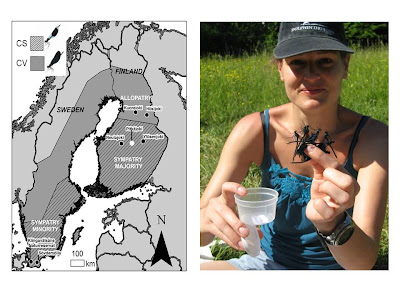Here is a follow-up post on that theme, briefly discussing one of our most recently published articles that is now out in
Evolution. The abstract for that article
can be found here, but since this journal is not yet open source (unfortunately) you cannot access the entire article. If you are interested in a pre-print or reprint, please contact me or Maren Wellenreuther(
maren.wellenreuther@zooekol.lu.se).
This study was a collaborative project together with our colleague Katja Tynkkynen at University of Jyväskylä, and the experiments were performed in the summer of 2008. The basic idéa was to investigate the potential consequences of the future range expansion in the calopterygid damselfly
C. splendens ("CS" see picture on map above!), which is soon expected to move north in to the allopatric zone in Northern Scandinavia of its close relative
C. virgo ("CV"; see picture above). These two morphologically similar congeneric damselflies are sympatric over the major part of Europe, and it is only in the northern areas that
C. virgo occurs alone (i. e., allopatry), and where
C. splendens does not yet occur (see map above).
However, things might change in the future:
a recent study have revealed that C. splendens and many other damselfly and dragonfly species are currently expanding northwards in response to increasing temperatures and ongoing climate change. Increasing temperatures are particularly affecting ectothermic animals like damselflies and other insects, which respond very rapidly to the ongoing climate change in Europe and elsewhere in the northern Hemisphere. Thus, we would soon expect that dispersing individual
C. splendens on the move from the south will encounter the isolated
C. virgo populations in the north. As usual, the issue of "animal movement" is the key to many fascinating biological phenomena!
What will happen when the more southern species
C. splendens expands in to the zone where "naive"
C. virgo populations have been isolated for quite long time? Have these northern allopatric
C. virgo populations lost their species recognition ability entirely, i. e. do they not discriminate against heterospecifics anymore? This would be expected, since (per definition) there cannot be any selection for species recognition in the absence of heterospecifics. Alternatively, since these northern
C. virgo populations are most likely derived from southern populations that expanded northwards after the last Ice Age, they might still have a genetic evolutionary "memory" and discriminate against heterospecifics, that is based on their past evolutionary interactions with
C. splendens when they co-occurred in the south.
We investigated this by experimentally simulating range expansion ourselves: we took
C. splendens females from the sympatric zone in southern Finland and transported them to northern Finland where they were presented to the local
C. virgo males. We then recorded the local male's reaction to this "novel" female phenotype and compared with the responses of
C. virgo males in the sympatric zone. It turned out, rather surprisingly, that northern
C. virgo males from the allopatric zone
did actually show some discrimination against heterospecific
C. splendens females, although the level of mate discrimination was weaker than among
C. virgo males from the sympatric zone in the south. Thus, mate recognition against heterospecifics had been lost, although not entirely so. This will have some consequences for what to expect following range expansions in these and other insect species.
One potential risk of range expansions following climate change are changed interspecific interactions, which can lead to local extinctions, e. g. through hybridizations and/or heterospecific matings. This risk might not be as great as one might fear in this damselfly species pair, since obviously some level of mate recognition and ability to discriminate against heterospecifics is still there. The interesting remaining question is of course: how long will a maladaptive (or at least neutral) trait that is no longer maintained by selection persist, and why do these
C. virgo males still discriminate against heterospecific females long after they run any risk of meeting them?
SIMULATING RANGE EXPANSION: MALE SPECIES RECOGNITION AND LOSS OF PREMATING ISOLATION IN DAMSELFLIES
Wellenreuther M, Tynkkynen K, Svensson EI.
Prolonged periods of allopatry might result in loss of the ability to discriminate against other formerly sympatric species, and can lead to heterospecific matings and hybridization upon secondary contact. Loss of premating isolation during prolonged allopatry can operate in the opposite direction of reinforcement, but has until now been little explored. We investigated how premating isolation between two closely related damselfly species, Calopteryx splendens and C. virgo, might be affected by the expected future northward range expansion of C. splendens into the allopatric zone of C. virgo in northern Scandinavia. We simulated the expected secondary contact by presenting C. splendens females to C. virgo males in the northern allopatric populations in Finland. Premating isolation towards C. splendens in northern allopatric populations was compared to sympatric populations in southern Finland and southern Sweden. Male courtship responses of C. virgo towards conspecific females showed limited geographic variation, however, courtship attempts towards heterospecific C. splendens females increased significantly from sympatry to allopatry. Our results suggest that allopatric C. virgo males have partly lost their ability to discriminate against heterospecific females. Reduced premating isolation in allopatry might lead to increased heterospecific matings between taxa that are currently expanding and shifting their ranges in response to climate change.
Evolution. 2009 Aug 6. [Epub ahead of print]


